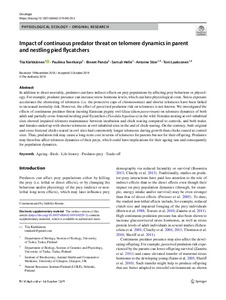Impact of continuous predator threat on telomere dynamics in parent and nestling pied flycatchers
Toni Laaksonen; Samuli Helle; Antoine Stier; Pauliina Teerikorpi; Tiia Kärkkäinen; Bineet Panda
Impact of continuous predator threat on telomere dynamics in parent and nestling pied flycatchers
Toni Laaksonen
Samuli Helle
Antoine Stier
Pauliina Teerikorpi
Tiia Kärkkäinen
Bineet Panda
SPRINGER
Julkaisun pysyvä osoite on:
https://urn.fi/URN:NBN:fi-fe2021042824282
https://urn.fi/URN:NBN:fi-fe2021042824282
Tiivistelmä
In addition to direct mortality, predators can have indirect effects on prey populations by affecting prey behaviour or physiology. For example, predator presence can increase stress hormone levels, which can have physiological costs. Stress exposure accelerates the shortening of telomeres (i.e. the protective caps of chromosomes) and shorter telomeres have been linked to increased mortality risk. However, the effect of perceived predation risk on telomeres is not known. We investigated the effects of continuous predator threat (nesting Eurasian pygmy owl Glaucidium passerinum) on telomere dynamics of both adult and partially cross-fostered nestling pied flycatchers (Ficedula hypoleuca) in the wild. Females nesting at owl-inhabited sites showed impaired telomere maintenance between incubation and chick rearing compared to controls, and both males and females ended up with shorter telomeres at owl-inhabited sites in the end of chick rearing. On the contrary, both original and cross-fostered chicks reared in owl sites had consistently longer telomeres during growth than chicks reared at control sites. Thus, predation risk may cause a long-term cost in terms of telomeres for parents but not for their offspring. Predators may therefore affect telomere dynamics of their preys, which could have implications for their ageing rate and consequently for population dynamics.
Kokoelmat
- Rinnakkaistallenteet [19249]
